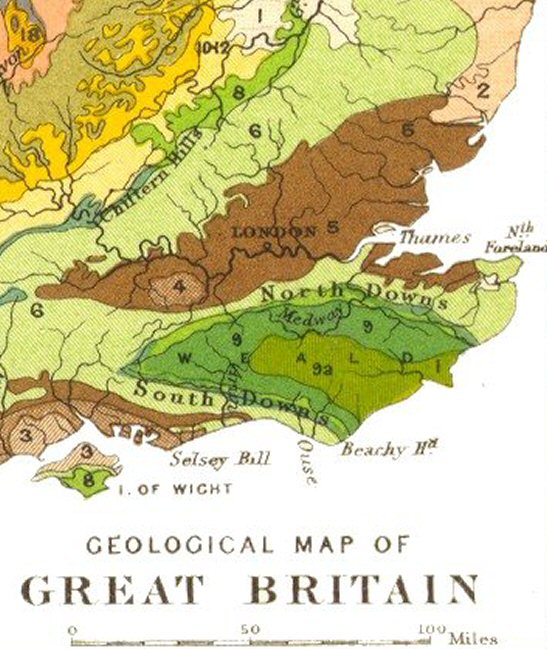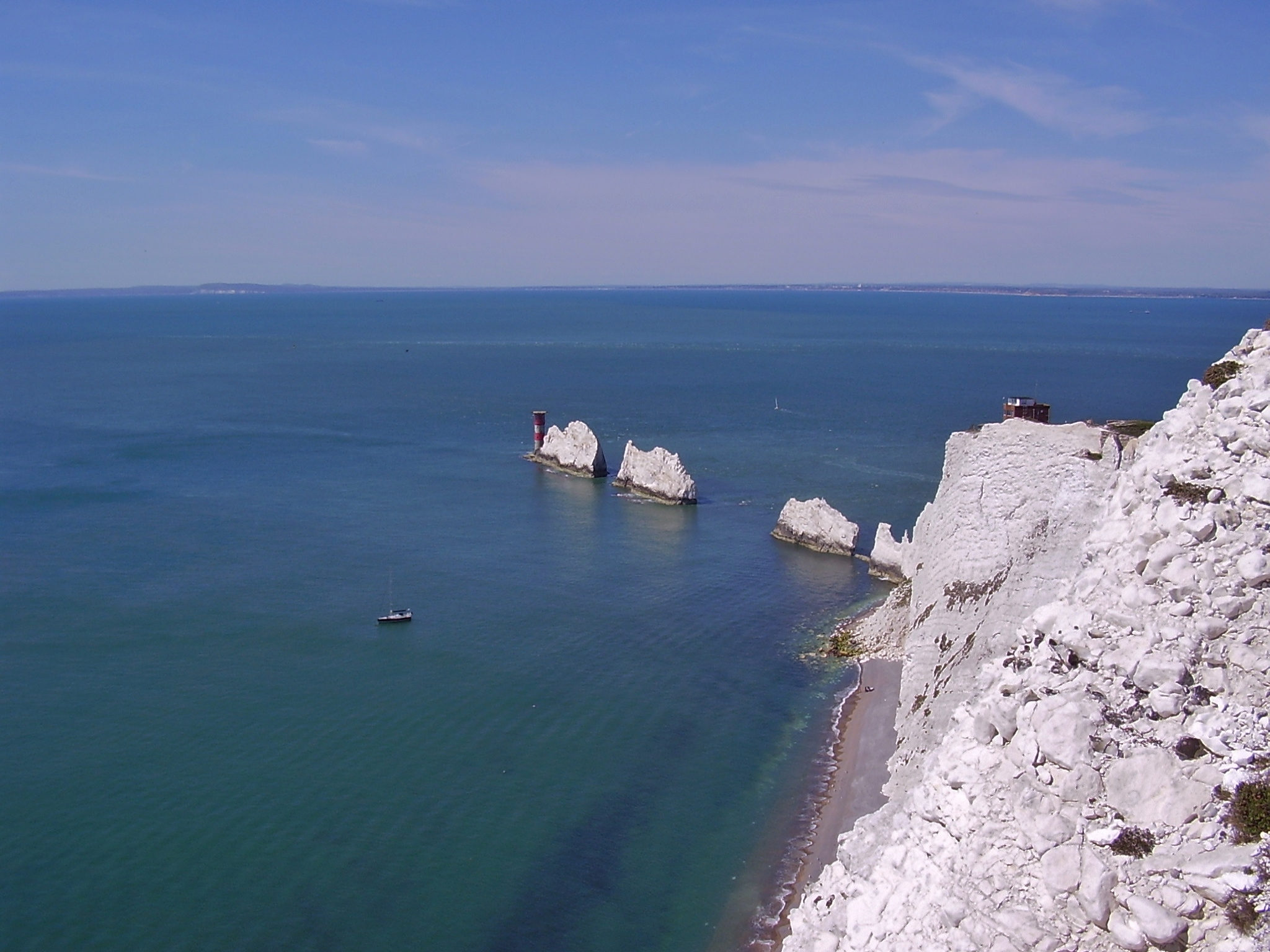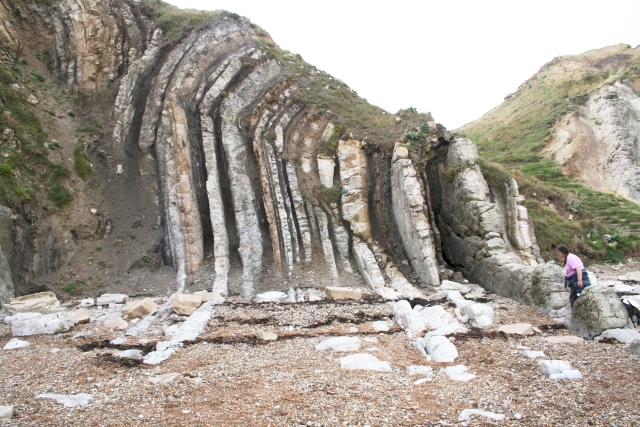|
Hampshire Basin
The Hampshire Basin is a geological basin of Palaeogene age in southern England, underlying parts of Hampshire, the Isle of Wight, Dorset, and Sussex. Like the London Basin to the northeast, it is filled with sands and clays of Paleocene and younger ages and it is surrounded by a broken rim of chalk hills of Cretaceous age. Extent The Hampshire Basin is the traditional name for the landward section of a basin underlying the northern English Channel and much of central southern England, known more fully as the Hampshire- Dieppe Basin. It stretches a little over 100 miles (160 km) from the Dorchester area in the west to Beachy Head in the east. Its southern boundary is marked by a monocline, the Purbeck Monocline, resulting in a near-vertical chalk ridge which forms the Purbeck Hills of Dorset, running under the sea from Old Harry Rocks to The Needles and the central spine of the Isle of Wight and continuing under the English Channel as the Wight- Bray monocline. The ... [...More Info...] [...Related Items...] OR: [Wikipedia] [Google] [Baidu] |
Geologic Map SE England & Channel EN
Geology () is a branch of natural science concerned with Earth and other astronomical objects, the features or rocks of which it is composed, and the processes by which they change over time. Modern geology significantly overlaps all other Earth sciences, including hydrology, and so is treated as one major aspect of integrated Earth system science and planetary science. Geology describes the structure of the Earth on and beneath its surface, and the processes that have shaped that structure. It also provides tools to determine the relative and absolute ages of rocks found in a given location, and also to describe the histories of those rocks. By combining these tools, geologists are able to chronicle the geological history of the Earth as a whole, and also to demonstrate the age of the Earth. Geology provides the primary evidence for plate tectonics, the evolutionary history of life, and the Earth's past climates. Geologists broadly study the properties and processes ... [...More Info...] [...Related Items...] OR: [Wikipedia] [Google] [Baidu] |
Cretaceous
The Cretaceous ( ) is a geological period that lasted from about 145 to 66 million years ago (Mya). It is the third and final period of the Mesozoic Era, as well as the longest. At around 79 million years, it is the longest geological period of the entire Phanerozoic. The name is derived from the Latin ''creta'', " chalk", which is abundant in the latter half of the period. It is usually abbreviated K, for its German translation ''Kreide''. The Cretaceous was a period with a relatively warm climate, resulting in high eustatic sea levels that created numerous shallow inland seas. These oceans and seas were populated with now-extinct marine reptiles, ammonites, and rudists, while dinosaurs continued to dominate on land. The world was ice free, and forests extended to the poles. During this time, new groups of mammals and birds appeared. During the Early Cretaceous, flowering plants appeared and began to rapidly diversify, becoming the dominant group of plants across the Ear ... [...More Info...] [...Related Items...] OR: [Wikipedia] [Google] [Baidu] |
Cranborne Chase
Cranborne Chase () is an area of central southern England, straddling the counties Dorset, Hampshire and Wiltshire. It is part of the Cranborne Chase and West Wiltshire Downs Area of Outstanding Natural Beauty (AONB). The area is dominated by, and often considered to be synonymous with, a chalk downland plateau. Part of the English Chalk Formation, it is adjacent to Salisbury Plain and the West Wiltshire Downs in the north, and the Dorset Downs to the south west. The highest point is Win Green Down, in Wiltshire, at . Historically a medieval hunting forest, the area is also noted for its Neolithic and Bronze age archaeology and its rural agricultural character. Definitions As an informally defined region, the boundaries of Cranborne Chase vary depending on usage. When defined as the chalk plateau, it is clearly bounded by escarpments which face the valleys of the Blackmore Vale to the west, the Vale of Wardour to the north, and the Hampshire Avon to the east. To the sout ... [...More Info...] [...Related Items...] OR: [Wikipedia] [Google] [Baidu] |
Salisbury Plain
Salisbury Plain is a chalk plateau in the south western part of central southern England covering . It is part of a system of chalk downlands throughout eastern and southern England formed by the rocks of the Chalk Group and largely lies within the county of Wiltshire, but stretches into Hampshire. The plain is famous for its rich archaeology, including Stonehenge, one of England's best known landmarks. Large areas are given over to military training and thus the sparsely populated plain is the biggest remaining area of calcareous grassland in northwest Europe. Additionally the plain has arable land, and a few small areas of beech trees and coniferous woodland. Its highest point is Easton Hill. Physical geography The boundaries of Salisbury Plain have never been truly defined, and there is some difference of opinion as to its exact area. The river valleys surrounding it, and other downs and plains beyond them loosely define its boundaries. To the north the scarp of the ... [...More Info...] [...Related Items...] OR: [Wikipedia] [Google] [Baidu] |
South Downs
The South Downs are a range of chalk hills that extends for about across the south-eastern coastal counties of England from the Itchen valley of Hampshire in the west to Beachy Head, in the Eastbourne Downland Estate, East Sussex, in the east. The Downs are bounded on the northern side by a steep escarpment, from whose crest there are extensive views northwards across the Weald. The South Downs National Park forms a much larger area than the chalk range of the South Downs and includes large parts of the Weald. The South Downs are characterised by rolling chalk downland with close-cropped turf and dry valleys, and are recognised as one of the most important chalk landscapes in England. The range is one of the four main areas of chalk downland in southern England. The South Downs are relatively less populated compared to South East England as a whole, although there has been large-scale urban encroachment onto the chalk downland by major seaside resorts, including most no ... [...More Info...] [...Related Items...] OR: [Wikipedia] [Google] [Baidu] |
Pays De Bray
The Pays de Bray (, literally ''Land of Bray'') is a small (about 750 km²) natural region of France situated to the north-east of Rouen, straddling the French departments of the Seine-Maritime and the Oise (historically divided among the Provinces of Normandy and Picardy since 911, now divided among the administrative regions of Normandy and Picardy). The landscape is of bocage, a land use which arises from its clay soil, and is suited to the development of pasture for the raising of dairy cattle. It produces famous butters and cheeses such as Neufchâtel.info site on the Pays de Bray. Etymology Etymologically, the name of ''Bray'' comes from the Gaulish word ''braco'', which became the[...More Info...] [...Related Items...] OR: [Wikipedia] [Google] [Baidu] |
The Needles
The Needles is a row of three stacks of chalk that rise about out of the sea off the western extremity of the Isle of Wight in the English Channel, United Kingdom, close to Alum Bay and Scratchell's Bay, and part of Totland, the westernmost civil parish of the Isle of Wight. The Needles Lighthouse stands at the outer, western end of the formation. Built in 1859, it has been automated since 1994. The waters and adjoining seabed form part of the Needles Marine Conservation Zone and the Needles along with the shore and heath above are part of the Headon Warren and West High Down Site of Special Scientific Interest. The formation takes its name from a fourth needle-shaped pillar called Lot's Wife, which collapsed in a storm in 1764. The remaining rocks are not at all needle-like, but the name has stuck. The Needles were featured on the BBC Two TV programme ''Seven Natural Wonders'' (2005) as one of the wonders of Southern England. During Storm Eunice on 18 February ... [...More Info...] [...Related Items...] OR: [Wikipedia] [Google] [Baidu] |
Old Harry Rocks
Old Harry Rocks are three chalk formations, including a stack and a stump, located at Handfast Point, on the Isle of Purbeck in Dorset, southern England. They mark the most eastern point of the Jurassic Coast, a UNESCO World Heritage Site. Location Old Harry Rocks lies directly east of Studland, about northeast of Swanage, and about south of the large towns of Poole and Bournemouth. To the south are the chalk cliffs of Ballard Down, much of which is owned by the National Trust. The rocks can be viewed from the Dorset section of the South West Coast Path. Formation The chalk of Old Harry Rocks used to be part of a long stretch of chalk between Purbeck and the Isle of Wight, but remained as a headland after large parts of this seam were eroded away. As the headland suffered hydraulic action (a process in which air and water are forced into small cracks by the force of the sea, resulting in enlarging cracks), first caves, then arches formed. The tops of the arches collaps ... [...More Info...] [...Related Items...] OR: [Wikipedia] [Google] [Baidu] |
Purbeck Hills
The Purbeck Hills, also called the Purbeck Ridge or simply the Purbecks, are a ridge of chalk downs in Dorset, England. It is formed by the structure known as the Purbeck Monocline. The ridge extends from Lulworth Cove in the west to Old Harry Rocks in the east, where it meets the sea. The hills are part of a system of chalk downlands in southern England formed from the Chalk Group which also includes Salisbury Plain and the South Downs. For most of their length the chalk of the Purbeck Hills is protected from coastal erosion by a band of resistant Portland limestone. Where this band ends, at Durlston Head, the clay and chalk behind has been eroded, creating Poole Bay and the Solent. The ridge of steeply dipping chalk that forms the Purbeck Hills continues further east on the Isle of Wight. The height of the chalk ridge and proximity to Poole Harbour and the south coast have made the hills of strategic importance. There are a number of Iron Age, Roman and Saxon archae ... [...More Info...] [...Related Items...] OR: [Wikipedia] [Google] [Baidu] |
Purbeck Monocline
The Purbeck Monocline is a geological fold in southern England. The term 'fold' is used in geology when one or more originally flat sedimentary strata surfaces are bent or curved as a result of plastic (i.e. permanent) deformation. A monocline is a step-like fold, in which one limb is roughly horizontal. The Purbeck Monocline was formed during the late Oligocene and early Miocene epochs, about 30 million years ago. It is the northernmost 'ripple' of the Alpine Orogeny. The Purbeck Monocline gives rise to the prominent ridge of steeply dipping Cretaceous chalk which now forms the Purbeck Hills. This chalk band runs from Swyre Head via Flower's Barrow to Old Harry Rocks. From here the fold continues under the sea to The Needles and forms the central spine of the Isle of Wight. Here it is also known as the Purbeck-Isle of Wight Disturbance. The monocline continues under the English Channel as the Wight-Bray Monocline. The Purbeck Hills run east–west through the small br ... [...More Info...] [...Related Items...] OR: [Wikipedia] [Google] [Baidu] |
Monocline
A monocline (or, rarely, a monoform) is a step-like fold in rock strata consisting of a zone of steeper dip within an otherwise horizontal or gently-dipping sequence. Formation Monoclines may be formed in several different ways (see diagram) * By differential compaction over an underlying structure, particularly a large fault at the edge of a basin due to the greater compactibility of the basin fill, the amplitude of the fold will die out gradually upwards. * By mild reactivation of an earlier extensional fault during a phase of inversion causing folding in the overlying sequence. * As a form of fault propagation fold during upward propagation of an extensional fault in basement into an overlying cover sequence. * As a form of fault propagation fold during upward propagation of a reverse fault in basement into an overlying cover sequence. Examples * Waterpocket Fold in Capitol Reef National Park, Utah * Comb Ridge in southern Utah * Grandview-Phantom Monocline in Grand Can ... [...More Info...] [...Related Items...] OR: [Wikipedia] [Google] [Baidu] |
Beachy Head
Beachy Head is a chalk headland in East Sussex, England. It is situated close to Eastbourne, immediately east of the Seven Sisters. Beachy Head is located within the administrative area of Eastbourne Borough Council which owns the land, forming part of the Eastbourne Downland Estate. The cliff is the highest chalk sea cliff in Britain, rising to above sea level. The peak allows views of the south east coast towards Dungeness in the east, and to the Isle of Wight in the west. Geology The chalk was formed in the Late Cretaceous epoch, between 66 and 100 million years ago, when the area was under the sea. During the Cenozoic Era, the chalk was uplifted (see Cenozoic Era). When the last ice age ended, sea levels rose and the English Channel formed, cutting into the chalk to form the dramatic cliffs along the Sussex coast. Wave action contributes towards the erosion of cliffs around Beachy Head, which experience frequent small rock falls. Since chalk forms in layers sep ... [...More Info...] [...Related Items...] OR: [Wikipedia] [Google] [Baidu] |








.jpg)